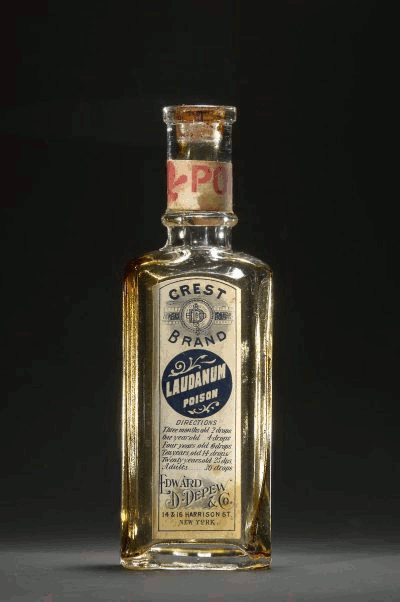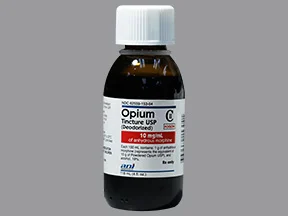[ Home ] [ Controlled Substances ] [ Opioids ]
OPIUM TINCTURE
|
NCI Dictionaries:
Opium Tincture:
Also known as laudanum and formulated for oral administration, opium tincture is made of air-dried poppy (Papaver somniferum) latex and contains alkaloids such as morphine and codeine. As an antidiarrheal agent, it slows transit of intestinal contents by increasing intestinal smooth muscle tone and inhibiting motility; water is absorbed from fecal contents, decreasing diarrhea.
 NCI Drug Dictionary opium tincture:
NCI Drug Dictionary opium tincture:
https://www.cancer.gov/publications/dictionaries/cancer-drug/def/opium-tincture
In 1676, physician Thomas Sydenham made perhaps the biggest impact on society by publishing his recipe for laudanum, sharing his discovery worldwide. As Inglis points out, 'Opium, through the old manuals, apothecary shops, and increasingly through laudanum, paregoric and Dover's powder, had found itself a place in almost every home.' It was so well-liked that it was used for ailments until after the Second World War. The side-effects of laudanum were expanded upon by surgeon George Young, who wrote in 1753: 'Everybody knows a large dose of laudanum will kill, so need not be cautioned on that head; but there are few who consider it a slow poison, though it certainly is.' Its addictive qualities were noticed particularly in women, who, according to French doctor J. Hector St John de Crevecour, were 'taking a dose of opium every morning, and so deep-rooted is it that they would be at a loss how to live without this indulgence'.

https://www.historytoday.com/reviews/history-opium
Opium was becoming one of, if not the most common medicine of the time. The tendency was to keep laudanum [a liquid form of the drug] on hand the way we keep Tylenol today, Gray says. There were no limits on the drug's use and no restrictions on who could purchase it. Twelve-year-olds might stop at a druggist to pick up a bottle for their mother. In a typical case of addiction, a patient would start taking laudanum or opium pills to treat a headache, insomnia, diarrhea, stomach pains, cholera or a toothache, and then three years later the person is still using it.


https://www.wbur.org/commonhealth/2017/08/01/opium-history-addiction
Hazard Alert: Recurring Confusion Between Tincture of Opium and Paregoric:
ISMP urges hospitals, community pharmacies, and other locations that use opium tincture and/or paregoric (camphorated tincture of opium) to take action immediately to minimize the risk of fatal confusion between these drugs. Last week, a Connecticut newspaper reported that a 51-year-old woman with chronic diarrhea died from morphine intoxication after receiving a teaspoonful of opium tincture (about 50 mg morphine) instead of paregoric. After a dose, the patient became weak, tired, and achy. Her son checked on her periodically, but when he tried to wake her later that day, she did not respond. Paramedics were summoned but they could not revive the woman.
Paragoric = Camphorated Tincture of Opium
Laudanum = Tincture of Opium

https://www.ismp.org/resources/hazard-alert-recurring-confusion-between-tincture-opium-and-paregoric
Prescribed for:
What Conditions does it Treat?
- Opioid drug dependence of a newborn
- Diarrhea caused by chemotherapy
- Diarrhea

Opium Tincture
(10 mg per mL of Morphine)Uses:
This medication is used to treat diarrhea. It helps to decrease how often you have bowel movements. It works by slowing the movement of the intestines. Opium belongs to a class of drugs known as opioid pain relievers, but this medication acts mainly to slow the gut.Since this medication slows the gut, it should not be used to treat diarrhea caused by poisoning until the toxin is removed from your gut.
Before using:
Tell your doctor or pharmacist your medical history, especially of:
- Brain disorders (such as head injury, tumor, seizures)
- Breathing problems (such as asthma, sleep apnea, chronic obstructive pulmonary disease-COPD)
- Kidney disease
- Liver disease
- Mental/mood disorders (such as confusion, depression)
- Personal or family history of a substance use disorder (such as overuse of or addiction to drugs/alcohol)
- Stomach/intestinal problems (such as blockage, constipation, diarrhea due to infection, paralytic ileus)
- Difficulty urinating (such as due to enlarged prostate)
- Disease of the pancreas (pancreatitis)
- Gallbladder disease
Precautions:
- This drug may make you dizzy or drowsy
- Alcohol or marijuana (cannabis) can make you more dizzy or drowsy
- Do not drive, use machinery, or do anything that needs alertness until you can do it safely.
- Avoid alcoholic beverages.
- Talk to your doctor if you are using marijuana (cannabis).
This product also contains alcohol. Caution is advised if you have diabetes, liver disease, or any other condition that requires you to limit/avoid alcohol in your diet.
Ask your doctor or pharmacist about using this product safely.User Reviews:
30 Total User Reviews Opium Tincture Oral:
Read ReviewsCondition: Diarrhea (27 Reviews): Effectiveness (4.44) Ease of Use (4.89) Satisfaction (4.30)

https://www.reddit.com/search/?q=laudanum
Danger of confusion with paregoric:
In the United States, opium tincture contains 10 mg per mL of anhydrous morphine. By contrast, opium tincture's weaker cousin, paregoric, also confusingly known as "camphorated tincture of opium", is 1/25th the strength of opium tincture, containing only 0.4 mg of morphine per mL. A 25-fold morphine overdose may occur if opium tincture is used where paregoric is indicated. Opium tincture is almost always dosed in drops, or fractions of a mL, or less commonly, in minims, while paregoric is dosed in teaspoons or tablespoons. Thus, an order for opium tincture containing directions in teaspoons is almost certainly in error. To avoid this potentially fatal outcome, the term "camphorated tincture of opium" is avoided in place of paregoric since the former can easily be mistaken for opium tincture.

| Opioids | Link to this page |



